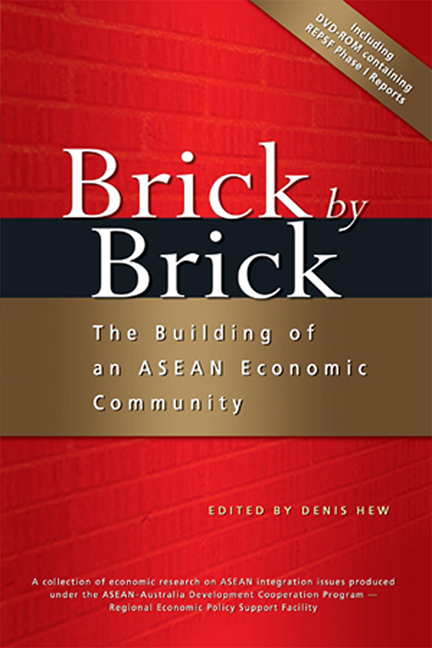Book contents
- Frontmatter
- Contents
- Foreword by Ong Keng Yong
- Foreword by Bruce Davis
- Acknowledgements by Academic Editor
- Acknowledgements by Technical Director REPSF
- The Contributors
- The Regional Economic Policy Support Facility
- 1 Introduction: Brick by Brick — The Building of an ASEAN Economic Community
- 2 What is a Single Market? An Application to the Case of ASEAN
- 3 The Challenge of Economic Integration for Transitional Economies of Southeast Asia
- 4 A Review of Regional Tariffs and Trade in the ASEAN Priority Goods Sectors
- 5 Non-tariff Barriers to Trade in the ASEAN Priority Goods Sectors
- 6 An Assessment of ASEAN's Priority Sectors for Fast-track Integration
- 7 ASEAN Tax Regimes: Impediment or Pathway to Greater Integration
- 8 An Overview of the Foreign Direct Investment Jurisprudence
- 9 ASEAN's FTA Negotiations with Dialogue Partners:Identifying Strengths and Weaknesses in Business Opportunities
- 10 Conclusion: Towards an ASEAN Economic Community by 2015
- Index
- Contents of Accompanying CD-ROM: AADCP-REPSF Phase I Research Program
8 - An Overview of the Foreign Direct Investment Jurisprudence
Published online by Cambridge University Press: 21 October 2015
- Frontmatter
- Contents
- Foreword by Ong Keng Yong
- Foreword by Bruce Davis
- Acknowledgements by Academic Editor
- Acknowledgements by Technical Director REPSF
- The Contributors
- The Regional Economic Policy Support Facility
- 1 Introduction: Brick by Brick — The Building of an ASEAN Economic Community
- 2 What is a Single Market? An Application to the Case of ASEAN
- 3 The Challenge of Economic Integration for Transitional Economies of Southeast Asia
- 4 A Review of Regional Tariffs and Trade in the ASEAN Priority Goods Sectors
- 5 Non-tariff Barriers to Trade in the ASEAN Priority Goods Sectors
- 6 An Assessment of ASEAN's Priority Sectors for Fast-track Integration
- 7 ASEAN Tax Regimes: Impediment or Pathway to Greater Integration
- 8 An Overview of the Foreign Direct Investment Jurisprudence
- 9 ASEAN's FTA Negotiations with Dialogue Partners:Identifying Strengths and Weaknesses in Business Opportunities
- 10 Conclusion: Towards an ASEAN Economic Community by 2015
- Index
- Contents of Accompanying CD-ROM: AADCP-REPSF Phase I Research Program
Summary
Outline of the Historical and Theoretical Perspectives
Foreign direct investment (FDI) activity in the strict sense, of consequence to international law, began in the mid-nineteenth century, essentially dominated by the capital exporting countries in Europe and surged dramatically after Second World War, but this time predominately led by the U.S. multinational corporations (MNCs). Traditionally, the recurring underlying reasons for MNCs to venture abroad include: to strategically capture world market, secure raw materials, minimize transaction costs and reap economies of scale, among others.
It follows that MNCs in the nineteenth and early twentieth centuries and still at present are pervasive power-wielding organizations: they can unleash political, social, and economic upheavals in the host countries. Not surprisingly, MNCs together with their home states have exerted demands to be treated to an external international law standard. Accordingly, for these reasons MNCs can be subjected to the regulatory controls of the host countries. Moreover, the popular Calvo doctrine squarely places MNCs treatment in par with national treatment, neither more nor less.
In the immediate post-colonial period, MNCs were still to a large extent, treated with suspicion by most of the independent states. Thus, these states were determined to pursue their right to “economic self-determination” without substantial foreign linkages.
There was, however, a complete paradigm shift in some developing countries' economic policy strategies in the 1980s — FDI was embraced as part of their overall development strategy. Muchinski (1995, p. 11) explains:
In the process a number of generalisations about MNEs have been put to doubt. First, it is clear that the MNE has not overwhelmed the nation state as a unit of power. States have responded to the issue of foreign direct investment and have used political power to coordinate economic power where necessary … Secondly, while early accounts of the MNE concentrated on its tendency towards monopoly, more recently awareness has arisen of the highly competitive nature of the international economy in which MNEs operate… Thirdly, the assumption can be discarded that the MNE is a uniform type of business entity whose behaviour can be predicted through logical deduction form its characteristics.
- Type
- Chapter
- Information
- Brick by BrickThe Building of an ASEAN Economic Community, pp. 144 - 174Publisher: ISEAS–Yusof Ishak InstitutePrint publication year: 2007

